A Bibliometric Analysis of Electronic Waste Management: Issues and Challenges
1
Indian Council of Social Science Research,
New Delhi,
India
2
School of Law,
Banasthali Vidyapeeth, Newai,
Tonk,
Rajasthan
India
3
School of Management,
Presidency University,
Bengaluru,
Karnataka
India
Corresponding author Email: shwetaduttsharma@gmail.com
DOI: http://dx.doi.org/10.12944/CWE.18.3.28
Copy the following to cite this article:
Sharma S, Mehta A, Sharma S. A Bibliometric Analysis of Electronic Waste Management: Issues and Challenges. Curr World Environ 2023;18(3). DOI:http://dx.doi.org/10.12944/CWE.18.3.28
Copy the following to cite this URL:
Sharma S, Mehta A, Sharma S. A Bibliometric Analysis of Electronic Waste Management: Issues and Challenges. Curr World Environ 2023;18(3).
Download article (pdf) Citation Manager Publish History
Select type of program for download
| Endnote EndNote format (Mac & Win) | |
| Reference Manager Ris format (Win only) | |
| Procite Ris format (Win only) | |
| Medlars Format | |
| RefWorks Format RefWorks format (Mac & Win) | |
| BibTex Format BibTex format (Mac & Win) |
Article Publishing History
| Received: | 2023-06-27 |
|---|---|
| Accepted: | 2023-11-02 |
| Reviewed by: | 
 Gomez Sanabria Adriana
Gomez Sanabria Adriana
|
| Second Review by: |

 Jyoti Giri
Jyoti Giri
|
| Final Approval by: | Dr. V. P. Tewari. |
Introduction
With the world moving towards sustainable behaviors, electronic waste offers new challenges to countries worldwide. According to the definition given under the Basel Convention, the Waste Electrical and Electronic Equipment (WEEE) is defined as “electrical or electronic equipment that is waste, including all components, sub-assemblies and consumables that are part of the equipment at the time the equipment becomes waste.” As per the Global E-waste Monitor 2019 1, only 17.4% of the total e-waste generated (53.6 million metric tons) was efficiently managed worldwide. It increased to 1.8 Mt in 2014, but the total e-waste generation significantly increased to 9.2 Mt in 2019. Thus, there is a considerable gap between the e-waste generated and recycled globally. The continent which reported the most efficient management of e-waste was Europe (42.5%), further led by Asia (11.7%) and henceforth by America (9.4%) and Oceania (8.8%) and then by Africa (0.9%) having the lowest rate1.
India discards around 1.7 million tons (Mt) of e-waste, making it the fifth largest producer of electrical and electronic waste in the world as per UN report2. Hence, it becomes imperative to understand the current scenario of e-waste management in an emerging economy like India. Thus, both the countries and consumers need to focus on consumption patterns and behaviors towards the purchase and disposal of these items3,4
Studies carried out in the field of e-waste management have particularly focussed on the challenges and issues ahead of countries worldwide (5,6). A life cycle analysis of e-waste, the production process itself involves a great deal of hazardous byproduct generation 7–9. After production, the purchase process by the consumers and their use also involves a lot of behavioural implications. Studies suggest using e-waste software and e-waste lenses, suggesting various strategies for effective electronic material handling and supply chain software management, which can lead to effective and efficient resource usage 4,10. The usage of blockchain technology, which is centred around tracking the origin, location and history of a device, has also been stated as a novel method to bring about real-time tracking and monitoring of the e-waste management chain11–14.
Garg et al.15 have reported that with the rapid technological changes and upgradation in gazettes, consumers upgrade their electronic devices at an alarming rate. The increased availability and multiple brands in electronic gadgets have also led to increasingly smaller life cycles of product use with the consumer, leading to increased e-waste generation (16–18However, studies by Laeequddin et al.19related to consumer intention towards safe disposal of their e-waste have reported that no direct regulations aid to influence consumer safe disposal intentions. Perceived social norms extend producer responsibility, and clear communication may aid in bringing out significant changes in consumer intentions20–22.
Most of the challenges are related to the health implications for citizens arising from uncontrolled waste (23–25). Further research in this area requires to be focussed on an amalgamation of e-waste and circular economy. This will ensure the waste resources are extracted, reused, and valued. This will aid in creating decent, sustainable jobs also eventually26,27.
Hence, the present study envisages the contribution made by various authors to developing this field of study, focusing on its further development. The novelty of this study lies in addressing the studies which present the emerging trends in this topic in the emerging economy of India. The growth in the consumer electronics market systematically necessitates proper e-waste management through policy and practice 28 . Besides, most of the electronic waste in India is still in the hands of the unorganized sector. It also attempts to explore answers to the following questions:
The present placement of “e-waste” in the literature?
What are the prominent areas being emphasised by researchers?
Which countries are contributing more literature to the field?
What is the relative position of India in the e-waste management field?
Which keywords are prominently used by authors in the e-waste domain in India?
Materials and Methods
The study incorporates the bibliometric analysis to analyse the recent practices in the field. The search was restricted to the Scopus database, which utilized the data from 2006 to 2023. Scopus database has been considered as it is known for its quality standards and wide coverage of information related to specific knowledge bases 29,30. The search with keywords “E-waste” and “India” resulted in 1595 articles. The studies on e-waste carried out in the context of the Indian territory were focussed upon for the study. The criteria for selection in the study were based on the PRISMA statement31. The PRISMA items are the reporting methods used in the systematic literature review. The steps have been illustrated in Figure 1. Articles from all over the world have been included without the exclusion of any country. Abstracts of all these articles were included in the study and were reviewed thoroughly to exclude any duplications. In the data extraction phase, 211 documents were selected, and the following characteristics were retained as the inclusion criteria:
Articles must be original papers, review papers or an editorial. Conference papers and case studies were also included.
The language used in the article must be English, and it should relate to any of the fields, including etc.
Extracted articles must be published during the period 2006-2023.
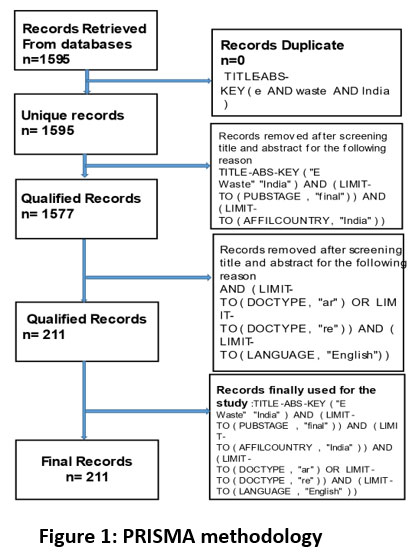 | Figure 1: PRISMA methodology
|
For the Bibliometric analysis VOS viewer program and Atlas Ti has been utilised to generate the visual maps based on the data extracted from various database. The research uses the network visualization technique whereby the labels represent the items they carry, and a circle represents the weight. Both the label and circle represent the total weight of the item. The greater the weight of the item, the bigger the circle. The colour reflects the cluster to which the item belongs. The distance between the circles indicates the relatedness of the items. Atlas Ti has been used to generate the concept mapping of the keywords used in the various studies. This study utilizes the Scopus database for extracting the studies based on e-waste studies in India. Various parameters like authors, co-authorship and citations have been used to generate visual maps. As per some studies 32 the quality and impact of research can be effectively analysed through the number of research citations. After the quantitative analysis, the study followed the qualitative analysis of the articles and selected 211 relevant papers related to the field.
The research uses the network visualization technique whereby the items reflect the label they carry and by a circle. Both the label and circle reflect the total weight of the item—the more the weight, the bigger the circle. The colour reflects the cluster to which the item belongs. The distance between the circles indicates the relatedness of the items.
Results
A comprehensive review of the studies carried out in the domain of e-waste in the Indian context has been listed in Table 1. Most of these studies are review articles and policy-related studies focussing on the contemporary and future challenges of e-waste management.
Table 1: List of Studies on E-waste in Indian context
Name of the Article | Author/s | Type of Study | Results | Limitations |
Managing E-Waste in India- A review | 33Saini A, Taneja A | Review Article | Conversion of waste to wealth through effective management of waste | Limited to specific waste types in the Indian context |
India’s E-waste Rules and Management | 34Bhaskar K, Turaga R | Case Study/Interview based | Extended producer responsibility policy considers instruments such as a deposit-refund system. | Only limited stakeholders located in Ahmedabad city were involved in the study. |
An overview of E-waste practices | 35Rajput R, Rinki, Nigam N | Review Article | Urbanization contributes to increased e-waste streams in the Indian context. | Limited to policies and legislation in the Indian context |
E-waste: A new challenge for waste management | 36Mundada M, Kumar S, Shekdar A | Empirical research | Present the waste stream generated and the course of action to be taken. | Focussed only on computer waste management |
Sustainability through remanufacturing of e-waste: | 37Singhal D, Tripathy S, Jena S | Exploratory | The study reflects the absence of autonomous factors by consumers of electronic goods. | Focussed only on the strategy of remanufacturing |
E-Wast: Issues and Strategies | 38Turaga R, Bhaskar K, […] Sharma H | Descriptive | Recent management of e-waste and the challenges ahead | Focussing only on extended producer responsibility |
Review of the Policy regarding e-waste in India | 39Borthakur A | Review Article | Current e-waste policies in India and the need for localized policies | Focussed only on legislative goals |
Management of e-waste in India | 40Jain S, Garg K | Exploratory | Focussed on Global agreements on e-waste disposal | Focuses on certain methods of waste disposal and their advantages |
E-waste management in India | 41Balakrishnan C, Rachel Priya J | Review | Generating awareness of the repercussions of improper e-waste disposal | Focussed only on the consumer perspective of waste generation and disposal |
A year-wise analysis of the 211 documents, as reflected in Figure 2, results in the maximum number of articles contributed by authors in the year 2021 and the initiation of the studies incorporating behavioral aspects from the year 2004. This year already, fifteen articles have been contributed to this field of study.
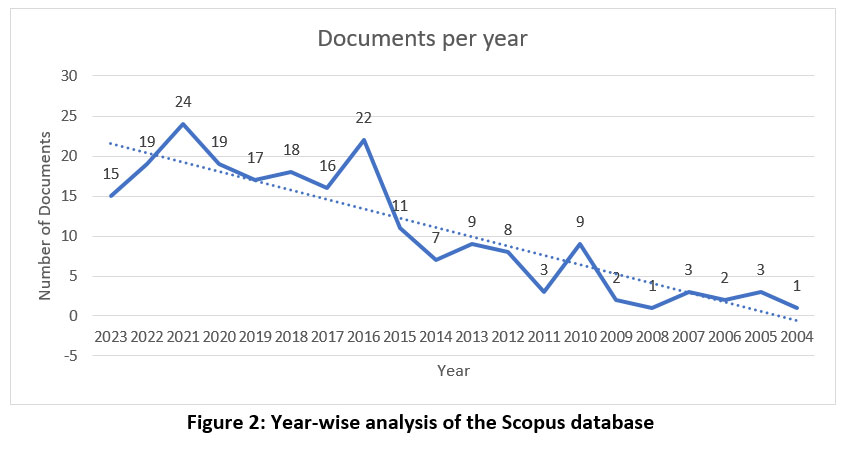 | Figure 2: Year-wise analysis of the Scopus database.
|
However, as per the number of publications (Figure 3), the results reflected an increased prominence of researchers like Li, J., Liu, Y., Li, Y., and Zhang Z. The colours reflect the clusters to which the authors belong.
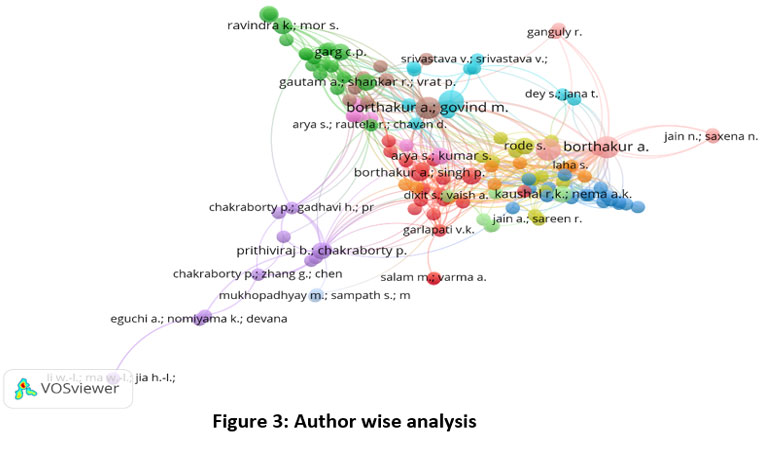 | Figure 3: Author wise analysis.
|
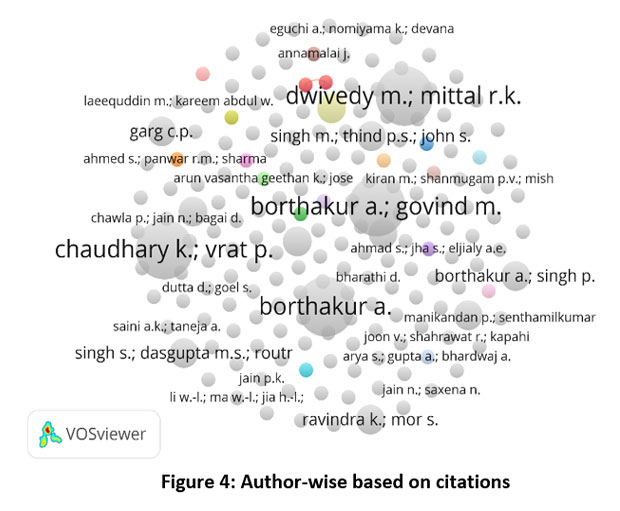 | Figure 4: Author-wise based on citations.
|
The data suggests that there has been a constant rise in the number of studies related to e-waste. The Author-wise analysis (Figure 4) based on the citations increased the visibility of authors like Borthakur, A., Dwivedi, M., Chaudhary, K., Govind, M., Mittal, R.K.
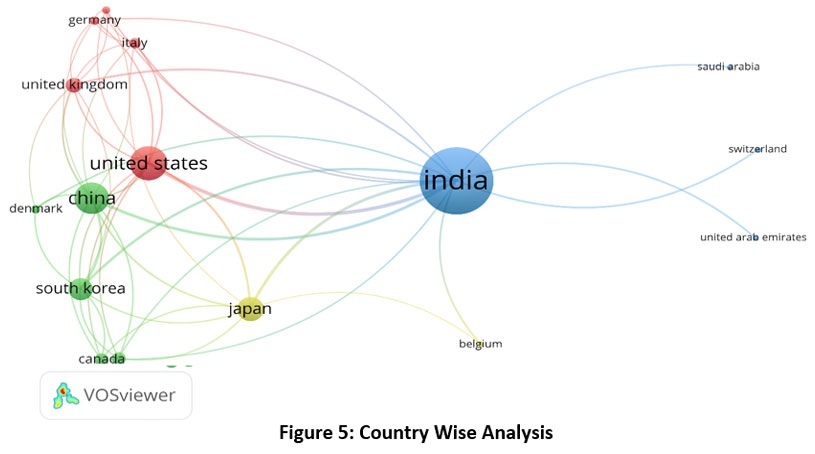 | Figure 5: Country Wise Analysis
|
The country-wise analysis (Figure 5) suggests a prominence of research from India in this field. This is further followed by research from the USA, China, South Korea, and Japan.
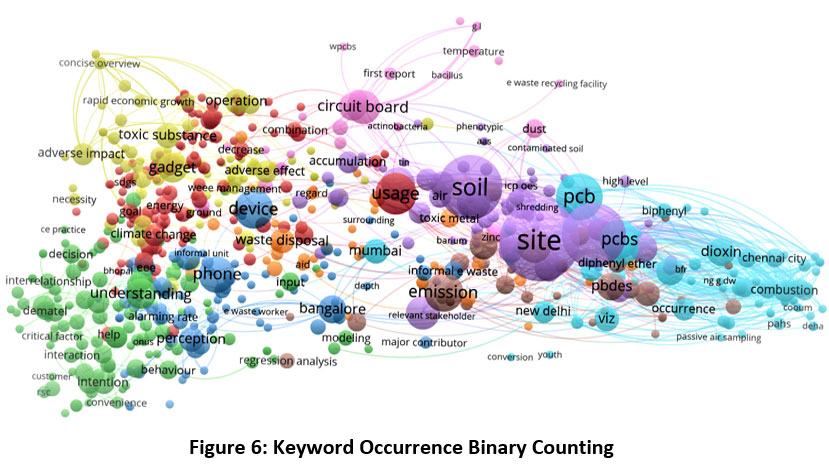 | Figure 6: Keyword Occurrence Binary Counting
|
The binary counting method (Figure 6) results in terms like soil, site circuit board, PCBs, Usage, etc. The colours reflect the clusters to which the keyword belongs. The maps for keyword content analysis have been performed through binary and full counting methods. In the case of binary counting, the occurrences reflect the number of occurrences of terms at least once in the documents.
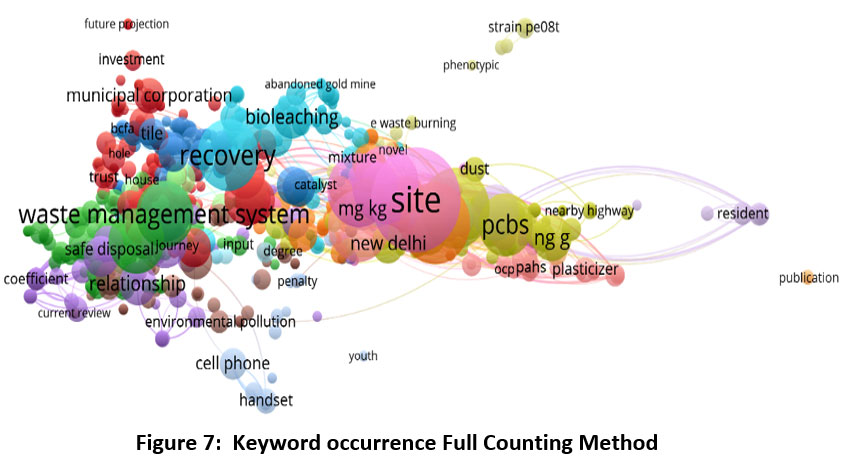 | Figure 7: Keyword occurrence Full Counting Method.
|
On the other hand, in full counting (Figure 7), the occurrences reflect the total number of occurrences of a term in all documents. Both methods have been used for keyword analysis. The full counting method enhances the visibility of waste management systems, sites, PCB, Intention and Municipal corporations.
Clustering
The keyword clustering based on the colors has been reflected in Table 2. It reflects the intellectual structure of the studies in three broad areas of waste recovery from sites (Green) to the role of municipal corporations(purple) and finally, the resident attitude towards e-waste (Yellow).
Table 2: Clustering based on keywords (Full Counting).
"Cluster 1(Green)" | "Cluster 2(Purple)" | "Cluster 3(Yellow)" |
Site | Municipal Corporation | Resident |
Recovery | Scrap Dealer | house |
Waste Management | Environmental Pollution | Adverse impact |
Relationship | Handset | covid |
PCB’s |
|
|
Intention |
|
|
The concept mapping (Figure 8) of the select relevant documents in the domain of e-waste resulted in the cloud formation where the major keywords utilized in the various documents were projected.
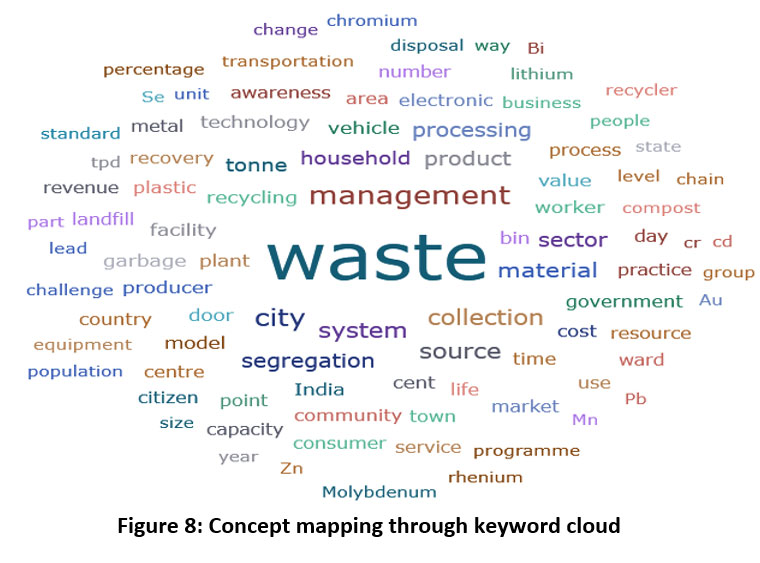 | Figure 8: Concept mapping through keyword cloud.
|
The concept mapping through the tree map (Figure 9) also reflects keywords like waste management and city, source, collection, and material in the assorted studies.
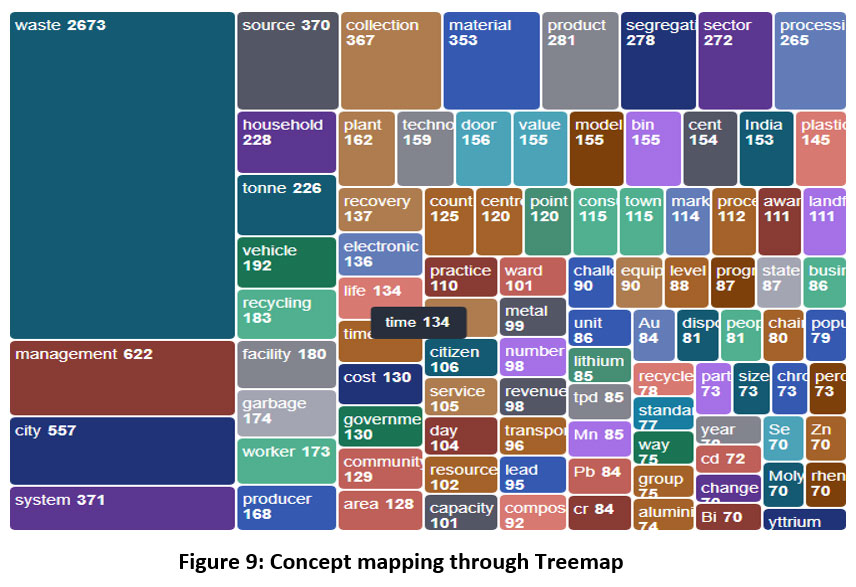 | Figure 9: Concept mapping through Treemap.
|
Discussion
There has been an increase in the studies related to contemporary management practices related to e-waste. The figures indicate an increase in the number of documents from 1 in 2004 to 15 in 2023. Thus, there has been increased attention being provided in the academic arena in this field.
The clustering reflects the prominent areas such as waste recovery, the role of the local bodies and the resident attitude towards e-waste management. Most of the research has been carried out stating the ill impact of this waste on the surrounding environment 42–44. Thus arises a significant challenge of handling this waste scientifically wherein important resources are recovered from the waste, and then the remains are safely disposed of. Several studies45,46 have also assessed the risk associated with the workers engaged in the recycling industry associated with e-waste. There also appears to be a greater risk with the open dump sites where no protective shields are provided to the workers. It thus emerges as an emerging public health challenge for the various stakeholders23,47Thus. There is an urgent need to manage this waste effectively and efficiently and sustain the various components of the ecosystem being damaged by this waste penetration48–50
The data concerning the country statistics reflects that the greatest number of published articles are in India compared to the US and China. The study results contrast with those reported by researchers51,52 followed by Japan, Canada, UK, and Germany. Since the severity of the problem rests highest in India, the concern is also high in developing nations like India for bringing out effective e-waste management. Most relevant articles with the term E-waste in the Scopus database have been contributed by authors from various fields.
Another limiting gap is the lack of studies in India related to the informal setup of the collection measures 53–56. Studies have emphasised the role of the parallel economy being run through the informal recycling facilities in India. There should thus be a policy and provision for governing the informal network and formalizing this sector slowly57,58. The keywords prominently used in the studies are waste, management, city, system and collection.
Another relevant information from this study is that the studies in this field have yet to focus on a complete life cycle analysis of e-waste. This calls for an urgent need to carry out studies which can analyze the cradle-to-grave features of this type of waste. This might help bring in early interventions and design policies and practices which cater to the stage-based need for e-waste management. Also, it might result in increased efficiency of waste identification and collection. The keywords suggest the underpinning of the research in related areas of e-waste management and its adverse influence on health and the sites where the waste is being dumped. Hence, studies should prioritize the intentions and attitudes of the residents while also simultaneously stressing the urgent need for proper e-waste management.
Conclusion
E-waste has been increasing at an alarming rate worldwide. It has captured the attention of policymakers and various stakeholders as it might create a burgeoning issue in the future. India, being a leader in consumer markets waste generation in future, is also likely to be on the higher end. The field of e-waste management has gained increased impetus from the academic community as many studies are being conducted to explore and envisage the best management practices for this waste. The results suggest that several publications are from developing countries like India, focusing on process management and resident attitudes toward managing e-waste. This study contributes to the identification and classification of numerous studies in e-waste management in India and reports the emergent trends in e-waste. Future studies should focus more on waste characterisation and specific methods to handle these waste streams. Studies should also focus more on consumer intention towards sustainably handling this waste.
Acknowledgement
The authors acknowledge the support provided by the Indian Council of Social Science Research for providing funding for this research work.
Conflict of Interest
The authors declare no conflict of interest.
Funding Sources
The author(s) received financial support from the Indian Council of Social Science Research, New Delhi, for conducting this research.
References
- Adrian S, Drisse MB, Cheng Y, et al. Quantities, Flows, and the Circular Economy Potential The Global E-Waste Monitor 2020.
- A New Circular Vision for Electronics Time for a Global Reboot.; 2019. www.weforum.org
- Garg S, Ahmad A, Madsen DØ, Sohail SS. Sustainable Behavior concerning Managing E-Wastes: Factors Influencing E-Waste Management among Young Consumers. Int J Environ Res Public Health. 2023;20(1). doi:10.3390/ijerph20010801
CrossRef - Arulanantham K, Elangovan NS. Environmental issues on electronic wastes and materials handling of e-waste using e-waste software. Journal of Environmental Protection and Ecology. 2020;21(6):2173-2180.
- Arya S, Kumar S. E-waste in India at a glance: Current trends, regulations, challenges and management strategies. J Clean Prod. 2020;271. doi:10.1016/j.jclepro.2020.122707
CrossRef - Trivedi V, Pandey KK, Trivedi A. Analyzing the challenges of e-waste management practices in India during COVID-19. Management of Environmental Quality: An International Journal. 2022;33(6):1611-1628. doi:10.1108/MEQ-12-2021-0273
CrossRef - Singhal D, Tripathy S, Jena SK. Sustainability through remanufacturing of e-waste: Examination of critical factors in the Indian context. Sustain Prod Consum. 2019;20:128-139. doi:10.1016/j.spc.2019.06.001
CrossRef - Dhir A, Koshta N, Goyal RK, Sakashita M, Almotairi M. Behavioral reasoning theory (BRT) perspectives on E-waste recycling and management. J Clean Prod. 2021;280. doi:10.1016/j.jclepro.2020.124269
CrossRef - Sharma H, Kumar H, Mangla SK. Enablers to computer vision technology for sustainable E-waste management. J Clean Prod. 2023;412. doi:10.1016/j.jclepro.2023.137396
CrossRef - Bhubalan K, Tamothran AM, Kee SH, et al. Leveraging blockchain concepts as watermarkers of plastics for sustainable waste management in progressing circular economy. Environ Res. 2022;213. doi:10.1016/j.envres.2022.113631
CrossRef - Chatterjee A, Abraham J. Efficient management of e-waste. International Journal of Environmental Science and Technology. 2017;14(1):211-222. doi:10.1007/s13762-016-1072-6
CrossRef - Jhariya MK, Sahu KP, Raj A. E-waste, a new challenge to the environmentalists. Nature Environment and Pollution Technology. 2014;13(2):333-338.
- Sharma H, Kumar H, Mangla SK. Enablers to computer vision technology for sustainable E-waste management. J Clean Prod. 2023;412. doi:10.1016/j.jclepro.2023.137396
CrossRef - Premalatha M, Tabassum-Abbasi, Abbasi T, Abbasi SA. The generation, impact, and management of E-Waste: State of the art. Crit Rev Environ Sci Technol. 2014;44(14):1577-1678. doi:10.1080/10643389.2013.782171
CrossRef - Garg S, Ahmad A, Madsen DØ, Sohail SS. Sustainable Behavior with Respect to Managing E-Wastes: Factors Influencing E-Waste Management among Young Consumers. Int J Environ Res Public Health. 2023;20(1). doi:10.3390/ijerph20010801
CrossRef - Borthakur A, Govind M. Emerging trends in consumers’ E-waste disposal behaviour and awareness: A worldwide overview with special focus on India. Resour Conserv Recycl. 2017;117:102-113. doi:10.1016/j.resconrec.2016.11.011
CrossRef - Laeequddin M, Kareem Abdul W, Sahay V, Tiwari AK. Factors That Influence the Safe Disposal Behavior of E-Waste by Electronics Consumers. Sustainability (Switzerland). 2022;14(9). doi:10.3390/su14094981
CrossRef - Thukral S, Shree D, Singhal S. Consumer behaviour towards storage, disposal and recycling of e-waste: systematic review and future research prospects. Benchmarking. 2023;30(3):1021-1072. doi:10.1108/BIJ-12-2021-0774
CrossRef - Laeequddin M, Kareem Abdul W, Sahay V, Tiwari AK. Factors That Influence the Safe Disposal Behavior of E-Waste by Electronics Consumers. Sustainability (Switzerland). 2022;14(9). doi:10.3390/su14094981
CrossRef - Srimathi H, Krishnamoorthy A, Dharshini S. E-waste management and awareness. International Journal of Scientific and Technology Research. 2019;8(11):2627-2631.
- Gomathi N, Rupesh PL. Study on business opportunities extracted from e-waste: a review. International Journal of Engineering and Technology(UAE). 2018;7(2.33 Speci):1106-1109.
- Tiwari D, Raghupathy L, Khan AS, Dhawan NG. A Study on the E-waste Collection Systems in Some Asian Countries with Special Reference to India. Nature Environment and Pollution Technology. 2019;18(1):149-156.
- Krishnamoorthy Y, Ma V, Sakthivel M, Sarveswaran G. Emerging public health threat of e-waste management: Global and Indian perspective. Rev Environ Health. 2018;33(4):321-329. doi:10.1515/review-2018-0021
CrossRef - Bharathi D. Health hazards and environmental impacts of E-waste - An overview. Journal of Advanced Zoology. 2019;40(2):168-177.
- Bharathi D. Health hazards and environmental impacts of E-waste - An overview. Journal of Advanced Zoology. 2019;40(2):168-177.
- Bhat V, Patil Y. An Integrated and Sustainable Model for E-Waste Management for Pune City Households. In: Journal of Physics: Conference Series. Vol 1964. ; 2021. doi:10.1088/1742-6596/1964/6/062111
CrossRef - A Glance at the World. Waste Management. 2012;32(9):1728-1731. doi:10.1016/j.wasman.2012.05.029
CrossRef - Neeta Misra, Sarina Bolla, Kalyan Bhaskar. E-Waste Roadmap 2023 for India.; 2023.
- Harzing AW, Alakangas S. Google Scholar, Scopus and the Web of Science: a longitudinal and cross-disciplinary comparison. Scientometrics. 2016;106(2):787-804. doi:10.1007/s11192-015-1798-9
CrossRef - Moed HF, Markusova V, Akoev M. Trends in Russian research output indexed in Scopus and Web of Science. Scientometrics. 2018;116(2):1153-1180. doi:10.1007/s11192-018-2769-8
CrossRef - Selcuk AA. A Guide for Systematic Reviews: PRISMA. Turk Arch Otorhinolaryngol. 2019;57(1):57-58. doi:10.5152/tao.2019.4058
CrossRef - Arora and Singh.
- Saini AK, Taneja A. Managing E-Waste in India- A review. International Journal of Applied Engineering Research. 2012;7(11 SUPPL.):2000-2005.
- Bhaskar K, Turaga RMR. India’s E-waste rules and their impact on E-waste management practices a case study. J Ind Ecol. 2018;22(4):930-942. doi:10.1111/jiec.12619
CrossRef - Rajput R, Rinki, Nigam NA. An overview of E-waste, its management practices and legislations in the present Indian context. Journal of Applied and Natural Science. 2021;13(1):34-41. doi:10.31018/jans.v13i1.2440
CrossRef - Mundada MN, Kumar S, Shekdar AV. E-waste: A new challenge for waste management in India. International Journal of Environmental Studies. 2004;61(3):265-279. doi:10.1080/0020723042000176060
CrossRef - Singhal D, Tripathy S, Jena SK. Sustainability through remanufacturing of e-waste: Examination of critical factors in the Indian context. Sustain Prod Consum. 2019;20:128-139. doi:10.1016/j.spc.2019.06.001
CrossRef - Turaga RMR, Bhaskar K, Sinha S, et al. E-Waste Management in India: Issues and Strategies. Vikalpa. 2019;44(3):127-162. doi:10.1177/0256090919880655
CrossRef - Borthakur A. Policy implications of e-waste in India: A review. Int J Environ Waste Manag. 2016;17(3-4):301-317. doi:10.1504/IJEWM.2016.078600
CrossRef - Jain S, Garg KM. Managing e-waste in India: Adoption of need-based solutions. Journal of Internet Banking and Commerce. 2011;16(3).
- Balakrishnan C, Rachel Priya J. E-waste management in India. Pollut Res. 2016;35(3):539-543.
- Annamalai J. Occupational health hazards related to informal recycling of E-waste in India: An overview. Indian J Occup Environ Med. 2015;19(1):61-65. doi:10.4103/0019-5278.157013
CrossRef - Singhal D, Lyngdoh T, Prabhakaran P. Knowledge, Attitude and Practice Study of Health Risks Among E-waste Recyclers in Delhi. J Health Pollut. 2021;11(29):1-14. doi:10.5696/2156-9614-11.29.210306
CrossRef - Singhal D, Lyngdoh T, Prabhakaran P. Knowledge, Attitude and Practice Study of Health Risks Among E-waste Recyclers in Delhi. J Health Pollut. 2021;11(29):1-14. doi:10.5696/2156-9614-11.29.210306
CrossRef - Singh M, Thind PS, John S. Health risk assessment of the workers exposed to the heavy metals in e-waste recycling sites of Chandigarh and Ludhiana, Punjab, India. Chemosphere. 2018;203:426-433.
doi:10.1016/j.chemosphere.2018.03.138
CrossRef - Chakraborty P, Selvaraj S, Nakamura M, Prithiviraj B, Cincinelli A, Bang JJ. PCBs and PCDD/Fs in soil from informal e-waste recycling sites and open dumpsites in India: Levels, congener profiles and health risk assessment. Science of the Total Environment. 2018;621:930-938. doi:10.1016/j.scitotenv.2017.11.083
CrossRef - Monika, Kishore J. E-waste management: As a challenge to public health in India. Indian Journal of Community Medicine. 2010;35(3):382-385. doi:10.4103/0970-0218.69251
CrossRef - Dixit S, Vaish A. Sustaining environment and organisation through e-waste management: A study of post-consumption behaviour for the mobile industry in India. International Journal of Logistics Systems and Management. 2013;16(1):1-15. doi:10.1504/IJLSM.2013.055559
CrossRef - Srivastava R, Dhingra T. Towards a model for effective e-waste management: A study of the software industry in India. Int J Environ Waste Manag. 2021;27(1):61-78. doi:10.1504/IJEWM.2021.111905
CrossRef - Alberto Albuquerque C, Henrique Pereira Mello C, Paulo Balestrassi P, et al. Electronic Junk: Best Practice of Recycling and Production Forecast Case Study in Brazil ISO 9000-Management System View Project Electronic Junk: Best Practice of Recycling and Production Forecast Case Study in Brazil. https://www.researchgate.net/publication/318380957
- Alberto De Albuquerque C, Henrique C, Mello P, et al. Bibliometric analysis of studies involving e-waste: a critical review. doi:10.1007/s11356-021-15420-1/Published
CrossRef - Udhayakumar T, Parthasarathy P, Chowdhury RS, Preethi G. E-waste recycling-informal versus formal. Int J Econ Res. 2017;14(9):453-458.
- Tiwari D, Mehra G, Khan AS, Dhawan NG. A systemic approach to formalizing the informal sector in e-waste. Ann Biol. 2019;35(2):173-180.
- Laha S. Governing the network: Trust in E-waste informality in India. Geoforum. 2022;134:1-12. doi:10.1016/j.geoforum.2022.05.016
CrossRef - Dasgupta D, Majumder S, Adhikari J, et al. Environmental impact of e-waste management in Indian microscale informal sectors. Environmental Science and Pollution Research. 2023;30(11):29581-29597. doi:10.1007/s11356-022-23700-7
CrossRef - Bandyopadhyay A. A regulatory approach for e-waste management: A cross-national review of current practice and policy with an assessment and policy recommendation for the Indian perspective. Int J Environ Waste Manag. 2008;2(1-2):139-186. doi:10.1504/IJEWM.2008.016998
CrossRef - Singh S, Dasgupta MS, Routroy S. Analysis of Critical Success Factors to Design E-waste Collection Policy in India: A Fuzzy DEMATEL Approach. Environmental Science and Pollution Research. 2022;29(7):10585-10604. doi:10.1007/s11356-021-16129-x
CrossRef







